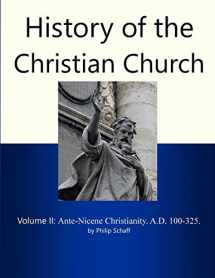
History of the Christian Church, Volume II: Ante-Nicene Christianity. A.D. 100-325.
Book details
Summary
Description
History of the Christian Church, Volume II: Ante-Nicene Christianity. A.D. 100-325. PREFACE TO THE SECOND EDITION This second volume contains the history of Christianity from the end of the Apostolic age to the beginning of the Nicene. The first edict of Toleration, A. D. 311, made an end of persecution; the second Edict of Toleration, 311 (there is no third), prepared the way for legal recognition and protection; the Nicene Council, 325, marks the solemn inauguration of the imperial state-church. Constantine, like Eusebius, the theologian, and Hosius, the statesman, of his reign, belongs to both periods and must be considered in both, though more fully in the next. We live in an age of discovery and research, similar to that which preceded the Reformation. The beginnings of Christianity are now absorbing the attention of scholars. During the present generation early church history has been vastly enriched by new sources of information, and almost revolutionized by independent criticism. Among the recent literary discoveries and publications the following deserve special mention: The Syriac Ignatius (by Cureton 1845 and 1849), which opened a new chapter in the Ignatian controversy so closely connected with the rise of Episcopacy and Catholicism; the Philosophumena of Hippolytus (by Miller 1851, and by Duncker and Schneidewin, 1859), which have shed a flood of light on the ancient heresies and systems of thought, as well as on the doctrinal and disciplinary commotions in the Roman church in the early part of third century; the Tenth Book of The Pseudo-Clementine Homilies (by Dressel, 1853), which supplements our knowledge of a curious type of distorted Christianity in the post-apostolic age, and furnishes, by an undoubted quotation, a valuable contribution to the solution of the Johannean problem; the Greek Hermas from Mt. Athos (the Codex Lipsiensis, published by Anger and Tischendorf, 1856); a new and complete Greek MS. of the First Epistle of the Roman Clement with several important new chapters and the oldestwritten Christian prayer (about one tenth of the whole), found in a Convent Library at Constantinople (by Bryennios, 1875); and in the same Codex the Second (so called) Epistle of Clement, or post-Clementine Homily rather, in its complete form (20 chs. instead of 12), giving us the first post-apostolic sermon, besides a new Greek text of the Epistle of Barnabus; a Syriac Version of Clement in the library of Jules Mohl, now at Cambridge (1876); fragments of Tatian’s Diatessaron with Ephraem’s Commentary on it, in an Armenian version (Latin by Mösinger 1878); fragments of the apologies of Melito (1858), and Aristides (1878); the complete Greek text of the Acts of Thomas (by Max Bonnet, 1883); and the crowning discovery of all, the Codex Sinaiticus, the only complete uncial MS. of the Greek Testament, together with the Greek Barnabus and the Greek Hermas (by Tischendorf, 1862), which, with the facsimile edition of the Vatican Codex (1868–1881, 6 vols.), marks an epoch in the science of textual criticism of the Greek Testament and of those two Apostolic Fathers, and establishes the fact of the ecclesiastical use of all our canonical books in the age of Eusebius. In view of these discoveries we would not be surprised if the Exposition of the Lord’s Oracles by Papias, which was still in existence at Nismes in 1215, the Memorials of Hegesippus, and the whole Greek original of Irenaeus, which were recorded by a librarian as extant in the sixteenth century, should turn up in some old convent. In connection with these fresh sources there has been a corresponding activity on the part of scholars. The Germans have done and are doing an astonishing amount of Quellenforschung and Quellenkritik in numerous monographs and periodicals, and have given us the newest and best critical editions of the Apostolic Fathers and Apologists.


We would LOVE it if you could help us and other readers by reviewing the book
Book review



